Knowledge Exchange for Resilience Annual Report 2022











This year, the Knowledge Exchange for Resilience has been “impatient for action but patient for outcomes.” These are the words of Maureen Bisognano, quoted in Dan Heath’s bestselling book Upstream [see page 11], and they are very appropriate to describe the current phase of our efforts to scale up our impact. In 2022, we expanded our capacity to bolster community resilience in transformative and significant ways. While we have not yet realized some of the important systems changes that our community needs, this work has taken root in several key ways that we are happy to share with you in this annual report.
We have deepened our engagement with the Council of Resilience Leaders, influential individuals from across Maricopa County who represent private, nonprofit and public sectors. As an external advisory group, the council supports KER in building Maricopa County’s capacity to adapt to shocks and stresses in ways that provide added benefits for its residents. They are helping us in three main ways.
We asked the council to help us expand our knowledge on what is going on in the community and vice versa, share with their networks the work that KER is doing.
Real change happens when someone acts on the knowledge we share. Small actions can turn into bigger — and more disruptive — actions.
We also asked the council to identify an organization in Arizona who will be recognized with the Resilience Prize. See page 15 to read about this year’s winner!
We have also increased our focus on concepts with “upstream” opportunities for systems change [see page 11]. The idea behind upstream thinking is to take a proactive stance ahead of the challenges we face, to avoid the downstream results that create the need for resilience action in the first place. While we still need to understand how to withstand shocks and stresses, we are also concerned about reducing the probability or magnitude of these shocks we know we will face. The upstream analogy is perfect when thinking about how to scale up impact because it means we look broadly for solutions and, in some cases, aim to solve problems before they even happen.


KER and ASU can’t do this alone. We need to continue to amplify our influence with stakeholders, including generating the intellectual and fiscal resources to support the work we do together. To do so, we are growing our partnerships and our funding in several key ways.
We are developing our capacity to engage with policy solutions. Read about this year’s Hunch Lunch on page 15.





We have expanded our reach with national level federal agencies. Read about our blossoming work with federal agencies on page 25.

Our team has leveraged the Piper Trust investment with even greater ROI. Dig into the numbers on page 37.
We have deepened our engagement with private sector partnerships. Learn about our collaboration with Swiss Re and 3M on page 33.
As our work continues, one of the challenges we have faced is that the concept of community resilience remains a difficult idea for individuals and organizations. The concept is complex because it could be interpreted as protecting communities from experiencing disasters and shocks, an effort to be “fail safe.” But it is near impossible to accurately predict what will happen in the future — even with systems that we truly understand. Can anyone honestly tell us when we might have the next global pandemic? Or how the housing and energy markets will affect us? Instead, building community resilience means acknowledging that there will be conditions and events that we cannot predict. But with better social networks, exchange of data and shared solutions, communities are better prepared to respond to all of these unknown shocks. We become “safe to fail”. As we patiently await what uncertainties the future holds, we will impatiently work to put into place the knowledge exchange needed for greater resilience.
Elizabeth Wentz Director and Principal Investigator wentz@asu.edu
 Patricia Solís Executive Director patricia.solis@asu.edu
Patricia Solís Executive Director patricia.solis@asu.edu


“At the KER, we believe that we are stronger when inclusive . By breaking down silos and bringing both data and people together, we can truly start to think upstream and be better prepared to respond to problems.”Photo courtesy of Friends of the Verde River
THE STATE OF BLACK ARIZONA & KER COUNCIL OF RESILIENCE LEADERS
The mission of the Knowledge Exchange for Resilience is to support Maricopa County, Arizona, by sharing knowledge, catalyzing discovery, and building solutions to catalyze change in order to build community resilience.

We work to support profound and enduring change across organizations to bring resilience dividends.
 ROBIN REED BLACK CHAMBER OF ARIZONA & KER COUNCIL OF RESILIENCE LEADERS
ROBIN REED BLACK CHAMBER OF ARIZONA & KER COUNCIL OF RESILIENCE LEADERS
“We’ve got to have data from trusted sources. … We’ve got to make sure we can look squarely in the eye of the challenges we have because you can’t overcome a challenge if you don’t admit you have it. … Having that data so we can see where our needs are is going to really be the key.”


We bring diverse people from across sectors together to share data, resources and lived experiences. Our approach gives community partners a central role in driving the research process to identify vulnerabilities, uncover assets and root causes, and develop potential solutions.
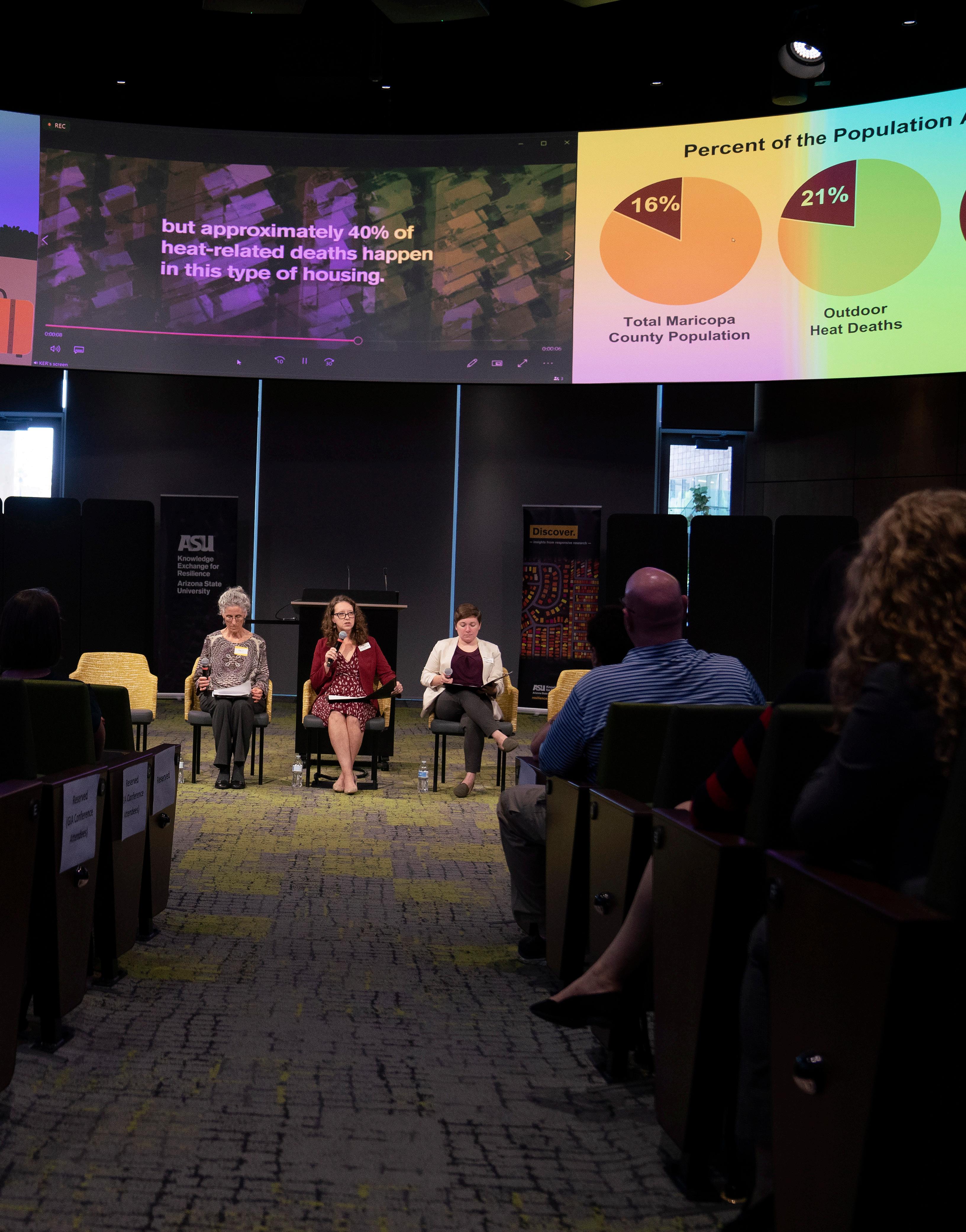

Our team marked a massive milestone this year, moving into the new Walton Center for Planetary Health and deepening our connections within the Julie Ann Wrigley Global Futures LaboratoryTM . We joined the rest of this community to celebrate ASU’s newest flagship research and teaching facility during Earth Week.
After an inspiring building dedication, we hosted the second meeting of our Council of Resilience Leaders. Formed last year, this group of influential local leaders met to discuss how they can amplify our work, advocate for community needs and opportunities, and award the annual Resilience Prize.
Council member Mayor Kate Gallego kicked off the proceedings by sharing how the City of Phoenix is addressing heat resilience through a first-of-its-kind Office of Heat Response and Mitigation.
Later that evening we welcomed old friends and new acquaintances to our new offices for an open house to meet our team and learn more about our work.
We also had the pleasure of hosting ASU’s YouthMappers chapter for a Mapathon, during which students learned how to create new spatial data for humanitarian organizations.

Turn to page 29 to learn about our collaboration with YouthMappers to support heat resilience by mapping Arizona’s mobile home communities.
To learn more about Earth Week with Julie Ann Wrigley Global Futures LaboratoryTM, visit globalfutures.asu.edu/earthweek






“Our Mapathon helped generate important spatial data that is used to promote health and sustainability both within the Phoenix Metropolitan Area and around the world.”
— BRYAN LEYBA, PRESIDENT ASU YOUTHMAPPERSKER Council of Resilience Leaders
Both university researchers and nonprofit organizations are typically invested in the health, wellness and stability of the communities where they live and work. Partnerships between them allow for the exchange of critical knowledge, experiential wisdom and cutting edge research that can help them more effectively achieve their goals.
Yet these groups are often unaware of their shared interests and how they might lead to productive collaboration. Finding partners across sectors often depends on existing connections, word of mouth or laborious internet searches that may overlook emerging researchers and smaller organizations.
“The tool can be used to identify opportunities for collaboration on service learning projects, proposals and other projects that bring together researchers and community organizations,” said Karna.
Its search platform allows users to type their name, their organization’s name or a research topic and find potential partners with a similar focus.
Ultimately, more efficient and effective partner searches can help universities, organizations and communities create better partnerships to achieve collective goals. Karna, Mathews and Solís aim to eventually expand the tool to include private sector organizations to facilitate partnerships across even more sectors.
In the meantime, the team is piloting the Knowledge Alliance Tool with potential end users to test its usefulness and incorporate their feedback before officially launching it. They are also working with ASU SkySong on patenting and licensing.
To learn more about the tool, reach out to any of our three creators: Brajesh Karna, brajesh.karna@asu.edu
Mason Mathews, mason.mathews@asu.edu Patricia Solís, patricia.solis@asu.edu
Brajesh Karna, KER’s data manager, Mason Mathews, associate director for academic integration and alliances, and executive director Patricia Solís worked to create a new tool that makes this process easier and more inclusive.
Dubbed the Knowledge Alliance Tool, it uses natural language processing and semantic network analysis to process information from online researcher profiles and organization websites to find interests that the groups have in common.

“Nothing quite like this existed. When we first launched KER, the need to systematically connect university and community partners required a novel data system that we had to create for ourselves.”
— PATRICIA SOLÍS, EXECUTIVE DIRECTOR
The





Assistant Research Professor and Associate Director for Academic Integration and Alliances
—
ASSISTANT RESEARCH PROFESSOR AND ASSOCIATE DIRECTOR FOR ACADEMIC INTEGRATION AND ALLIANCES
Brajesh Karna Data Manager Knowledge Exchange for Resilience
Patricia Solís Executive Director Knowledge Exchange for Resilience

Our annual Celebration for Resilience provided an opportunity to promote resilience concepts to a wider audience and to showcase individuals and organizations that are leading the way to build community resilience in Arizona.
This year we gathered at the historic Orpheum Theater around the idea of working upstream — heading off problems closer to their source rather than solely responding to their consequences.
Bestselling author Dan Heath gave the keynote, sharing examples from leaders across sectors who have learned to spot problems in advance and discussing the forces that incentivize downstream thinking as well as the levers that can be used to prevent problems before they
arise. The first 300 attendees at this year’s event received a complimentary copy of this influential book.
Following Heath’s talk, he joined a panel of local leaders, moderated by Univision political panelist and former Resilience Fellow Adonias Arevalo, to discuss how to apply upstream thinking to the most pressing challenges faced in Arizona.
We also recognized our partners, scholars and Resilience Fellows and awarded the annual Resilience Prize. This award celebrates a deserving organization, selected by our Council of Resilience Leaders, for its systemic efforts to improve community resilience in Arizona. Turn the page to learn about this year’s recipient.





“When you spend years responding to problems, you can sometimes overlook the fact that you could be preventing them.”
KER is thrilled to award the 2022 Resilience Prize to Friends of the Verde River for leading a diverse group of stakeholders to implement upstream, data-driven solutions to ensure the long term health of one of Arizona’s last free-flowing rivers.


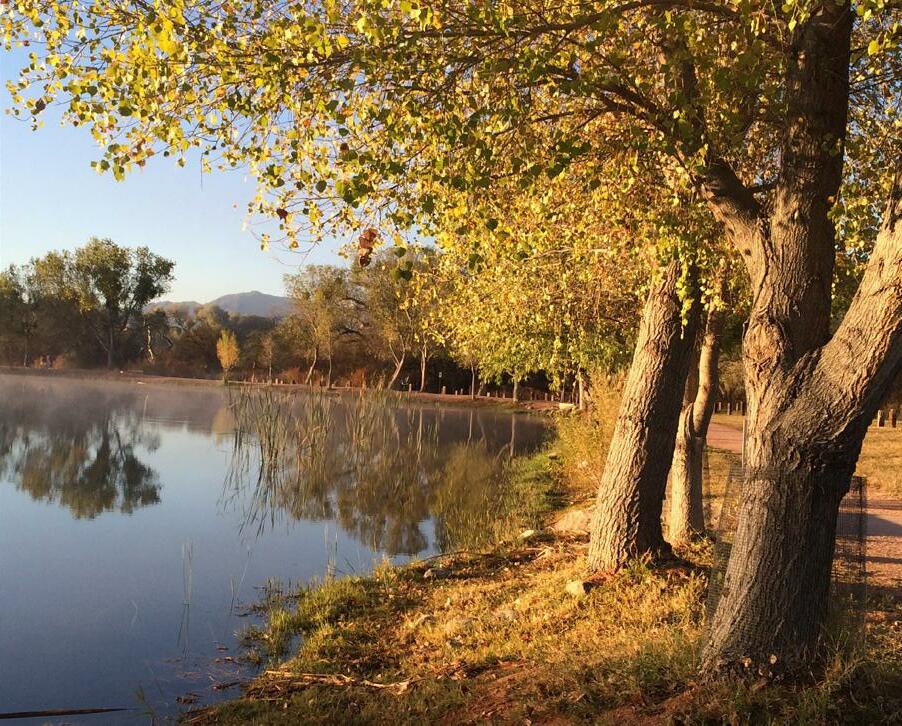
By highlighting collaborative, data-driven, systemic efforts to address the most urgent threats facing Arizona, the Resilience Prize brings widespread attention to the importance of building community resilience. Prize selection is informed by five elements of community resilience.*

While Friends began as an organization focused largely on removing invasive species and clearing river access points, they quickly expanded their efforts further upstream to address the underlying factors impacting the river’s health.
Their innovative Verde River Exchange and River Friendly Living certification programs incentivize homeowners, businesses and communities to reduce or offset their water usage. Friends also works to engage community members of all ages as “citizen scientists”. This not only bolsters their ability to collect water quality and biodiversity data, but it also fosters participants’ connection to the Verde, activating more and more advocates for the river.
In 2018, Friends partnered with The Nature Conservancy and the U.S. Forest Service to convene stakeholders throughout the region around a watershed report card. They released the report two years later, after deciding which indicators and metrics they’d use to measure the health of the river, habitat and community. The watershed scored a C+.

“Finding out that the river has declined as much as it has was kind of eye opening,” said Nancy Steele, Friends of the Verde River’s executive director. River base flows, for example, have decreased nearly 40% since 1990. “So ever since then, what we’ve been working on is projects specifically that will allow us to raise those scores.”
Having restored 12,000 acres of riverside habitat, offset more than 32 million gallons of groundwater pumping and engaged hundreds of volunteers and community scientists, their work has already borne dividends for Arizona residents and businesses.

Their habitat restoration strategy now includes an emphasis on restoring gullies to decrease erosion, replenish aquifers and reduce the frequency and severity of flash floods.
“It all starts upstream…far from the river, and as the water’s flowing downhill, it just gets going faster and faster and faster,” said Steele. “So let’s slow that water down, let’s get it to stay on the landscape longer, which means it’ll soak in.”
But the less tangible shifts they’ve achieved in building capacity, community and connection to the river may prove even more important to improving our water security, economy and wellbeing over the long term.
Friends of the Verde River demonstrates the value of leveraging collaboration and data to address root causes rather than symptoms of problems, and we are grateful for their example.
* These elements are awareness, diversity, integration, capacity for self-regulation and adaptiveness.
We will begin accepting nominations for the 2023 Resilience Prize in April at resilience.asu.edu/nominate

The Hunch Lunch is a KER signature event focused on breaking down knowledge silos by bringing together people from diverse perspectives to share their hunches around a particular resilience theme. This year, we partnered with the Salt River Project to explore the topic of energy transformations, particularly with regards to the electrification of transportation.
While enjoying a delicious catered meal, 54 attendees from various fields listened to five-minute flash talks from nine different perspectives, ranging from the utility and auto manufacturing sectors to air quality advocates and the fossil fuel industry.
Marc Campbell — now ASU’s University Sustainability Practices director — kicked off the hunches by emphasizing the need for a coordinated approach to transportation electrification. This sentiment was echoed by other speakers as they presented their visions of what the future of energy and transportation could look like.
Achieving these hopeful visions of the future will require careful planning to ensure no one is left behind. ASU’s Jennifer Vanos underlined this point: “As cities try to reduce greenhouse gas-intensive activities, especially through replacing cars with active transit … could there be unintended consequences of increasing heat and air pollution exposures to people?”
CHRISTY BOOS EXECUTIVE ANALYST SALT RIVER PROJECT

One such vision involves an energy grid that utilizes a multidirectional flow of energy, leveraging electric vehicles for energy storage. “When those vehicles get connected to the grid in a way that’s two-directional, it’s not just electricity that will flow two directions, it’s money,” said John Heckman, executive director of Anthesis.
JOANNA STROTHER SENIOR DIRECTOR FOR ADVOCACY AMERICAN LUNG ASSOCIATIONSmall group discussions following the hunches gave attendees the space to ask questions, share their own insights and discuss new ideas, like how to support small businesses and low-income families during the transition, the potential for ASU to study alternative models of road infrastructure funding, and how targeting the right employers for EV charger installation could lower barriers for lowincome residents and leverage solar energy.
One important point of consensus was the need to involve more developers in future conversations. “If we really want to reduce car trips altogether, whether it’s electric vehicles or petroleum vehicles, we need to consider how our land use interacts with our transportation choices,” said John Owens, Chandler’s downtown redevelopment specialist.
Watch the event recording at youtu.be/dHDkEerm2Fc.
“Hunch Lunch 2022 provided attendees with a great opportunity to hear a wide range of community experts share their ‘hunches’ and diverse perspectives about the transition to transportation electrification.”
“Increasing zero emission transportation and shifting to a non-combustion energy grid could yield $15.1 billion in public health benefits — and that’s just right here in Arizona if we started between now and the year 2050.”

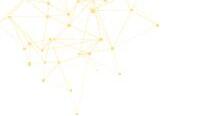


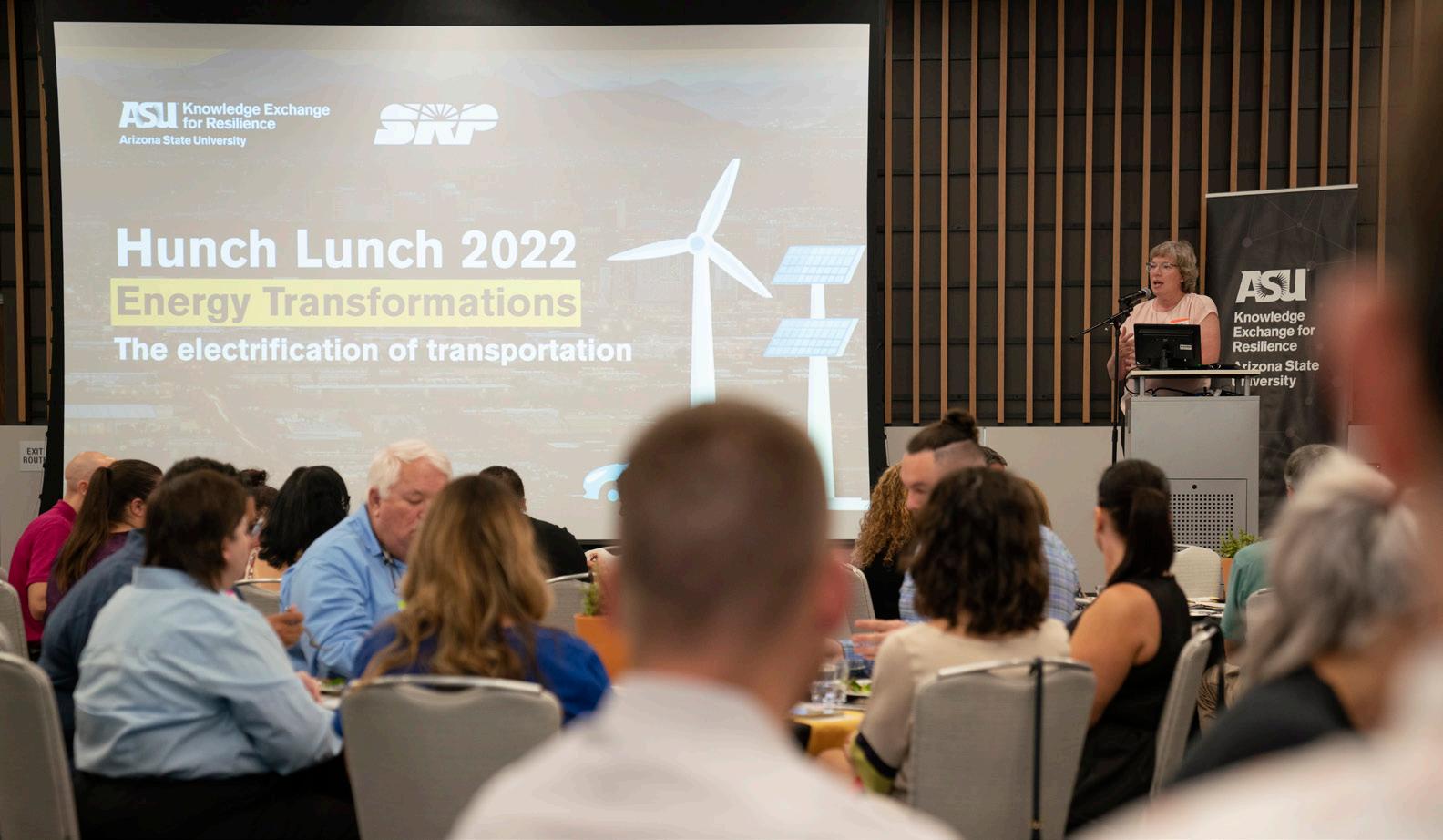



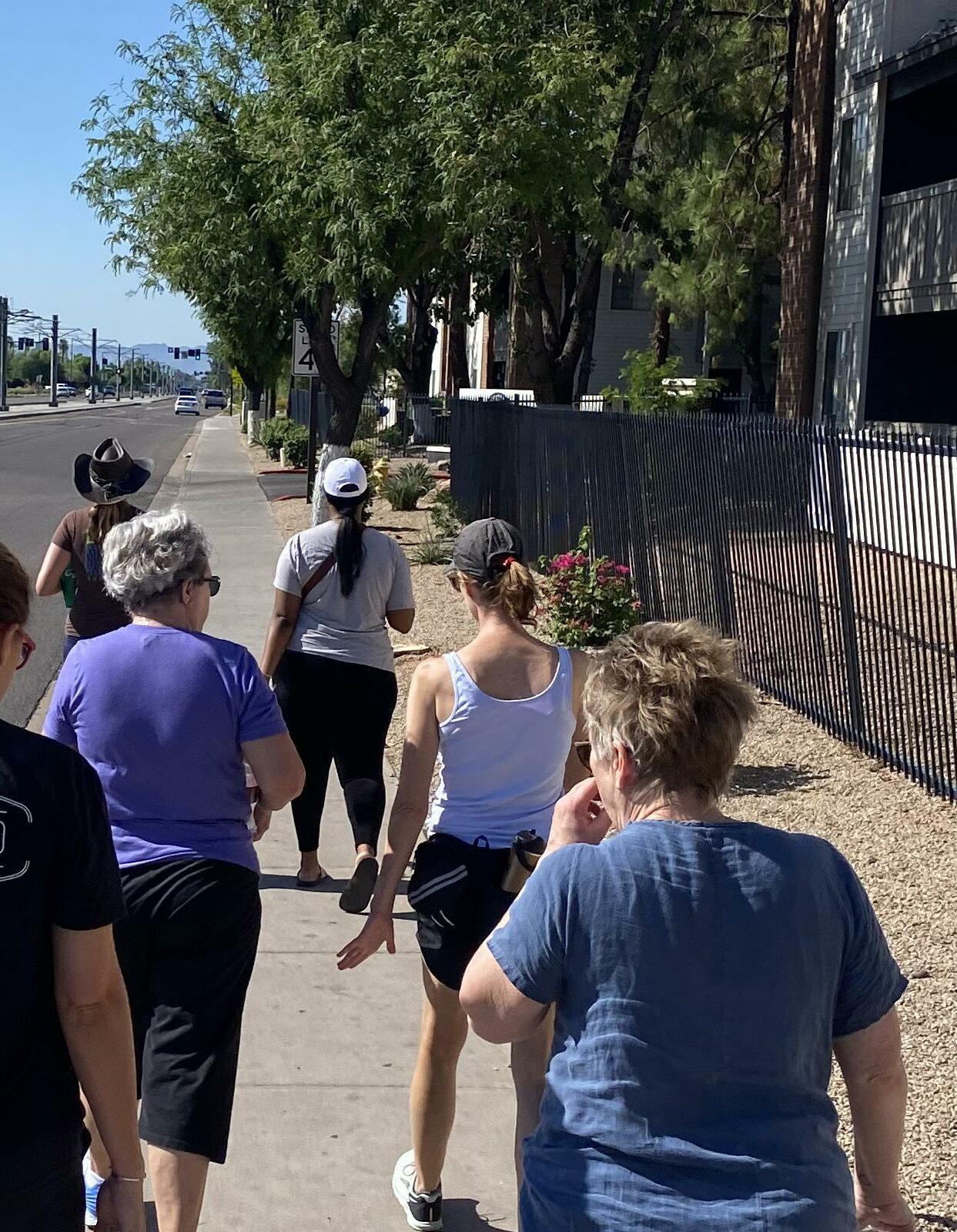
We collaborate with partners to perform responsive research that drives profound and enduring change. Together, we liberate, analyze, visualize and communicate knowledge from vast, diverse data to provide insights for action, laying the foundation for informed solutions.Photo courtesy of Michelle Litwin, City of Phoenix


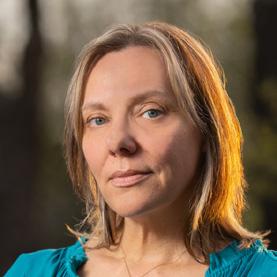

As we were creating the infrastructure to exchange knowledge about and for resilience, we designated a small cadre of ASU faculty and researchers to lend their expertise to our design and to more intricately engage with the university as a whole. Each undertook a specific question around building community resilience, and the group worked together to develop the Knowledge Exchange Playbook for Resilience
This year we introduced three new groups of scholars — one pulled from experts beyond ASU’s walls — who will build upon this work to expand our reach and amplify our impact for the next three years.

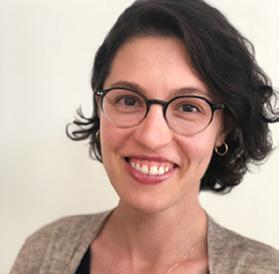

Our Enterprise Scholars are supporting the ongoing evolution of KER as we sustain our work to transform ASU as an institution. With their expertise, our resilience logic and most effective practices will be integrated as a design characteristic of the New American University. Named Enterprise Scholars for the three enterprises of ASU, these individuals are providing intellectual leadership for the model of a knowledge exchange contributing to research of public value.

As our Enterprise Scholars do the slow work of institutional transformation, our Impact Scholars are helping us respond quickly to the urgent threat of extreme heat in Arizona.







Our Community Scholars are contributing their wealth of knowledge from both business and nonprofit sectors to help us refine our methods of collaboration and find new opportunities to foster solutions.
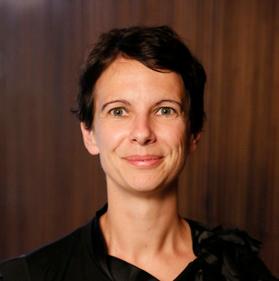

Each year we bring community experts and ASU researchers together for a year-long program to share ideas, develop their skills and conduct research on local vulnerabilities and solutions.
The cohort meets regularly so that as they explore resilience concepts and research practices, they also have the opportunity to teach and learn from one another. For example, as climate experts learn about the daily work of combating homelessness, and nonprofit managers pick up new data analysis skills, the fellows develop a network of supportive relationships to lean on while they study and implement changes to build community resilience.
Learn more about the program at resilience.asu.edu/resilience-fellows
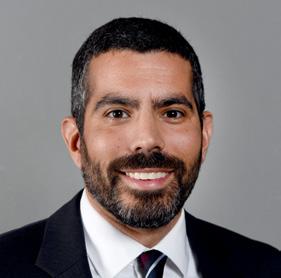
ASU Watts College of Public Service & Community Solutions
Can data sharing and care coordination improve health outcomes for high need unsheltered people?
resilience.asu.edu/adams-project
Adams tested the feasibility of identifying and prioritizing high cost, high need people experiencing homelessness to reduce crisis service utilization and cost to emergency systems. By including people impacted by the justice and health systems in program design and by improving care coordination and data sharing among these three systems, this strategy could result in up to 80% housing stability, as well as reductions of 25–50% in psychiatric hospitalizations and 30-50% in recidivism.

How can we extend access to desktop social services through community based support?
resilience.asu.edu/brickley-project
Addressing the rise in people living and dying unhoused, Brickley and Feed Phoenix hosted weekly community support events, organized their network around housing policy and created a
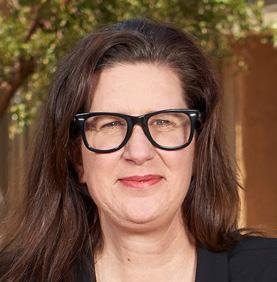
mobile office to extend social services directly to people in unsheltered encampments. Their community-led, mutual-aid approach could serve as an alternative support system to complement existing outreach programs.

ASU School of Sustainable Engineering and the Built Environment
How do we invest in infrastructure to strengthen the resilience and sustainability of our community?
resilience.asu.edu/chester-project
In order to encourage Arizona infrastructure professionals to plan for resilience and sustainability in a changing social and environmental context, Chester revamped the Sustainable Infrastructure Awards to acknowledge the increasingly highbrized built and ecological functions being implemented in resilience designs.
 Danae Hernández-Cortés
Danae Hernández-Cortés

ASU School for the Future of Innovation in Society & School of Sustainability
How do we monitor air quality for all metro Phoenix communities?
resilience.asu.edu/hernandez-cortes-project
Air quality monitoring provides information to communities and policy makers about pollution hazards, but monitoring stations are costly and scarce. Hernández-Cortés mapped the coverage of pollution monitoring stations in Maricopa County and analyzed potential ways in which pollution monitoring underserves minority communities. She then created an interactive tool that allows local organizations and policymakers to develop more equitable monitoring plans, pollution policies and programs.
Lori Holleran

Arizona Housing, Inc. (AHI)
Can supportive, affordable housing prevent the rise in homelessness among elders?
resilience.asu.edu/holleran-project
With the elderly share of the population experiencing poverty and homelessness expected to double in the next 15 years, Holleran piloted a supportive, affordable housing program that integrates digital literacy, social cohesion and health connectedness. She then developed recommendations related to nontraditional options for older adults entering the housing management system for the first time.
Michelle LitwinCity of Phoenix Green19: How do we prioritize and implement tree corridors to improve wellbeing?
resilience.asu.edu/litwin-project
Each year, more Americans die from extreme heat than in storms, floods and wildfires combined; city residents dependent on active and public transit face especially high risk. Litwin tested and refined a cool corridor prioritization toolkit, partnering with a local organization to plant trees in the 19 North Corridor. She used this experience to create a playbook for communities looking to implement cool corridors that equitably improve residents’ wellbeing.

Dress
Can preparing women for tech careers address needs for diversity, talent and community partnerships?

resilience.asu.edu/mcbath-project
McBath analyzed how skills preparation, career education and networking programs targeted at women can address the tech industry’s need for diversity, talent and community partnerships. While further study will be needed to explore long term effects on the industry’s gender disparity, participants did attain a wider range of career choice, find financially sustainable jobs and reduce their reliance on public assistance.

ASU Sustainable Cities Network

Can workshops support collaborative capacity for regional, equity-based resilience projects and policies?
resilience.asu.edu/reichman-project
Without significant coordinated planning and investment to build resilience, particularly related to extreme heat in underserved communities, our region will face serious economic and health crises. Reichman hosted a series of interactive workshops with key stakeholders in Maricopa County to build capacity and collaboration ahead of anticipated federal funding programs.
Mark RoselandASU School of Community Resources and Development

How can we transcend silos to advance community resilience?


resilience.asu.edu/roseland-project
Roseland is developing a decision-support dashboard tool that will allow communities to leverage community assets; assess progress toward resilience goals; and align plans, policies, and projects. This phase of his project piloted an urban forestry and tree cover dashboard for Phoenix, Tempe and Scottsdale and demonstrated that this kind of tool can help users develop innovative strategies for upstream action and investment.
ASU Edson College of Nursing and Health Innovation
Can low-literacy crisis recovery resources improve wellbeing for vulnerable community members?
resilience.asu.edu/heather-ross-project
Up to one in five Phoenix residents may have low literacy skills that make it difficult for them to absorb complex information about health and community resources, particularly in times of crisis. Ross translated crisis response materials used by Phoenix Fire Department to be more accessible for people with low literacy skills, providing a model other community programs can use to share information in a format all can access.
Keep
Can we enhance food security by improving community garden longevity? resilience.asu.edu/winburn-project
Winburn worked with local community gardens to create a network association and educational materials to help communities set up agribusiness structures for community gardens. In addition to supporting food security, health and social cohesion, these kinds of gardens build entrepreneurial skills and financial benefits and help ensure garden longevity, especially in underserved communities.
How do we build wealth and prevent displacement in Mesa’s Distrito Latino? resilience.asu.edu/winkle-project
Building on years of community engagement with Mesa’s Distrito Latino and Southside neighborhoods, Winkle worked with community leaders to host community engagement projects that culminated in the creation of a comprehensive wealth-building and anti-displacement strategy. This effort is equipping current residents and business owners with the tools to stay and thrive in the neighborhood they call home.
“The KER fellowship proved a fantastic experience — it really helped me expand my network beyond my usual contacts, plus I was able to leverage new resources and information for my project. It was great coordinating with others who are pushing for greater resilience in specific sectors or as a regional overall!”
 — ANNE REICHMAN 2022 ACADEMIC FELLOW
— ANNE REICHMAN 2022 ACADEMIC FELLOW
In the early days of the COVID-19 pandemic, pundits and politicians referred to it as an equalizer, a disease that couldn’t be evaded through power or privilege. Experts quickly pointed out that pandemics typically worsen existing health disparities. This one was no different.
No shock or stressor affects all communities equally, but what if decision-makers were able to see which neighborhoods are most vulnerable?
Last summer the U.S. Census Bureau released a dashboard called Community Resilience Estimates (CRE) that maps the prevalence of risk factors like poverty, age, disability and lack of internet access by census tract.
But not all shocks have the same risk factors. Our team reached out to work with them to create a more targeted version of this tool, one that maps vulnerability to extreme heat.
“A CRE for heat aims to help with planning to reduce and prevent heat related illness and death,” said R. Chase Sawyer, branch chief of survey analytics for the U.S. Census Bureau. We quickly suggested including housing data in the estimate. “We know from our research that the type of housing one lives in has a dramatic
impact on their exposure and thus their resilience to extreme heat,” said executive director Patricia Solís.
“Among outdoor heat associated deaths, nearly half are people experiencing homelessness; among indoor heat associated deaths, a disproportionate number live in older mobile homes.
“This connection between heat and housing insecurity is a threat multiplier but also a potential solutions multiplier. We can address heat health by addressing built environment needs.”
While the Census Bureau already collects data on housing type, they don’t track environmental risk factors for heat. KER GIS analyst Abdulrahman “Al” Alsanad is helping them blend data from other sources with their internal datasets, a method widely used by researchers in the academic and private sector, but not yet common in federal agencies because of the challenges of ingesting data from many sources.

“Temperature layers were hard to process for the whole country, so we talked about creating a tree cover layer and decided to start with that instead,” said Alsanad. Using spatial data from the U.S. Forest Service and GIS software, he mapped tree canopy cover by census block for all 50 states.
When complete, this dashboard will help stakeholders and decision-makers across the country target resources, information and interventions to the neighborhoods that are most at-risk in extreme heat. The tool may also serve as a pilot for future Census CREs that map vulnerability to other shocks and stresses.
Explore the current version of the Census Bureau’s Community Resilience Estimates at bit.ly/census-CRE
R. ChaseSawyer
Branch Chiefof Survey Analytics, U.S. Census Bureau
“The Census Bureau looks forward to continued collaboration with ASU on these life saving metrics that will help communities prepare and recover from disasters.”
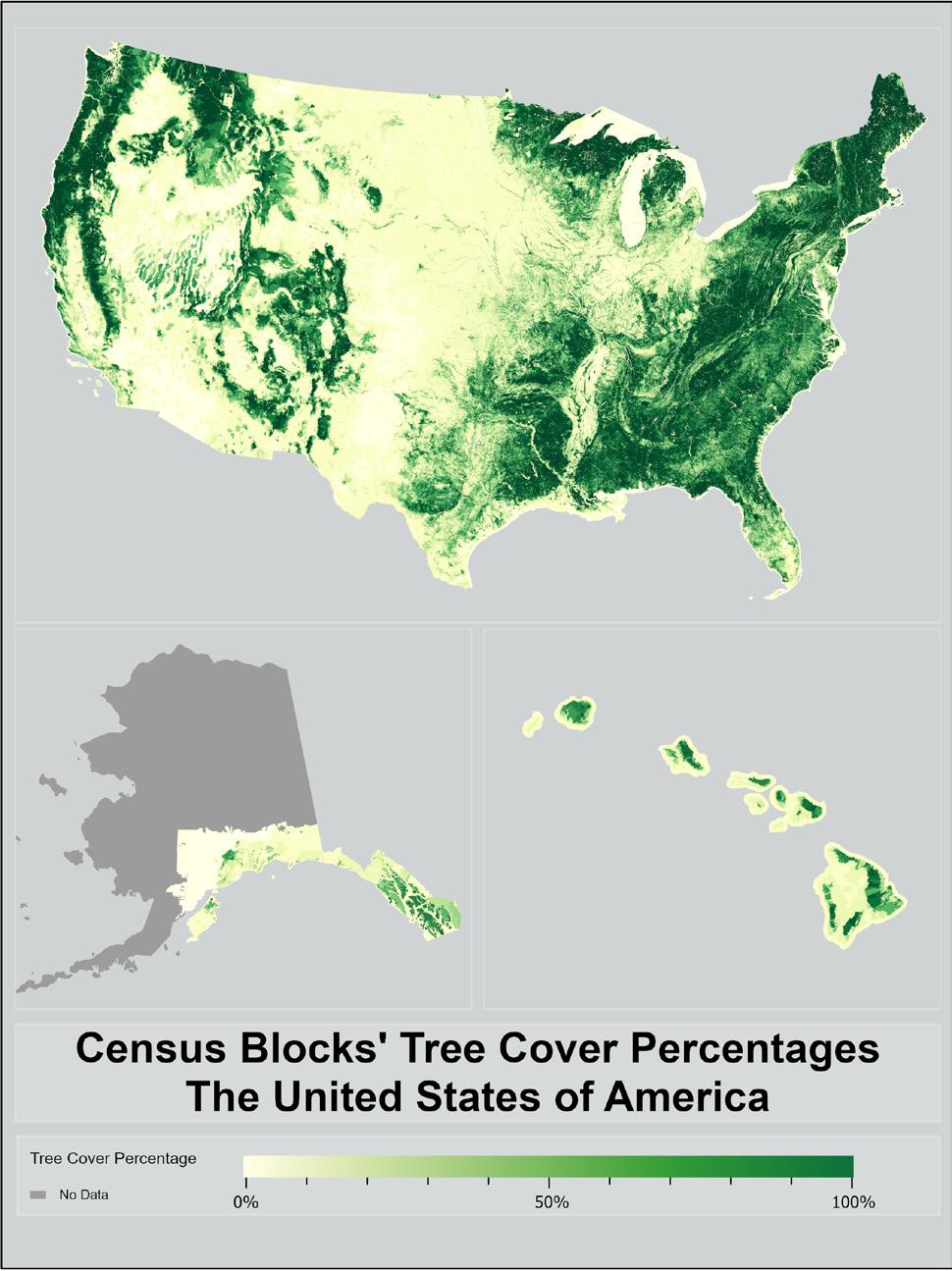
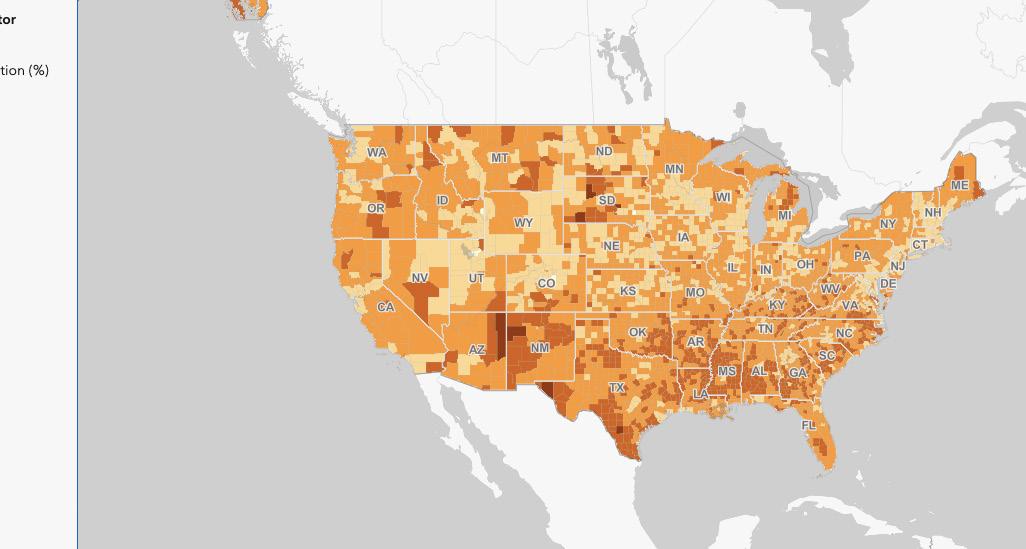

This summer KER participated in The Opportunity Project’s annual technology development sprints, which bring cross-sector partners together to solve national challenges using open data and digital innovation.
Associate director for broader impacts Lora Phillips served as an end user advocate for FEMA’s Building Community and Individual Climate Resilience sprint. In this role, she provided insights based on her expertise and community connections to help shape the products created by both industry and university tech teams.


KER is deeply rooted in the conviction that research can and should drive profound and enduring change. We focus on a responsive research agenda that engages partners across public, private and nonprofit sectors with the knowledge assets of the university. Here are some of our most influential research projects of the year.

Mobile home residents are especially vulnerable to extreme heat, but in order to effectively implement solutions, we need more reliable data about where they are. Our team is harnessing the power of citizen scientists and open data to create a database of Arizona mobile home park locations. Currently, there is no single, updated, comprehensive source for this information, which is critical to finding where solutions should be put into place.
In collaboration with YouthMappers, American Red Cross and the Missing Maps Project, we solicited mapping support on MapSwipe, an open-source mobile mapping app. In the project’s first week, 248 volunteers contributed by swiping through satellite images to identify mobile homes and parks that may be missing from our existing outdated datasets. In October, more than 1,000 volunteers participated, covering 49,000 km2 of southern Arizona.
After cross checking these results with our existing GIS data, as well as data from the county assessor’s office and the Arizona Association of Mobile Home Owners, we will have a more accurate picture of what mobile home residents face across the state.
Read more about this collaboration at tinyurl.com/InfoMHMP
In July, Maricopa County saw more evictions than any time since October 2008, in the aftermath of the foreclosure crisis. Building on our work to help communities and our housing stakeholder system target resources to reduce this number, we have been supporting New America and the Arizona Housing Coalition in promoting the new Foreclosure and Eviction Analysis Tool. This open-source data tool allows local stakeholders to easily analyze evictions within their community.
Meanwhile, Lora Phillips, our associate director for broader impacts, is working to identify the relationship between patterns of housing loss and property ownership, finding hot spots of vulnerability through rental properties with relatively high eviction rates. She is also studying whether certain categories of owners, such as non-local corporate landlords, are more likely to evict than others. Knowing which landlords are disproportionately evicting can inform common sense eviction mitigation solutions, developed alongside our community partners.
Learn more about the Foreclosure and Eviction Analysis Tool at bit.ly/foreclosure-eviction-tool
open spatial data and citizen science to support heat resilience
Studying patterns of property ownership and locations of housing loss



Universities and nonprofit community organizations often work together to solve pressing societal issues. While we know these partnerships are important, we know little about partnership belief systems.

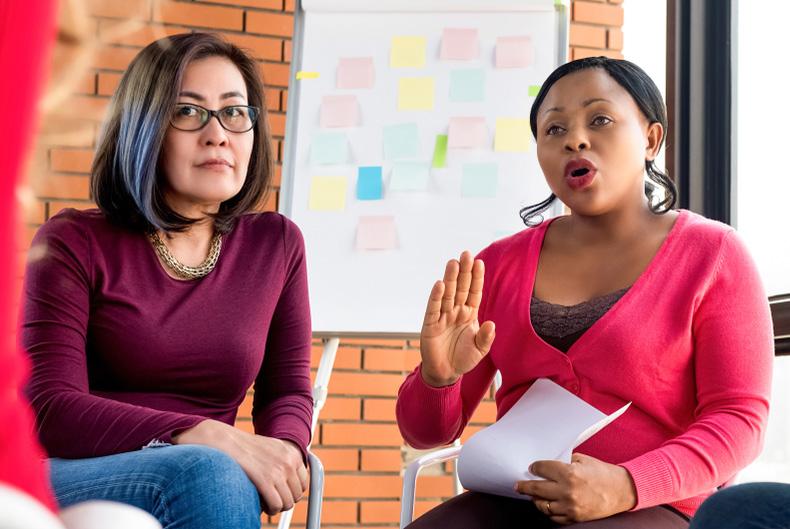

Mason Mathews, associate director for academic integration and alliances, and graduate research assistant Alexandria Drake have interviewed university personnel and local nonprofit employees to better understand their partnerships beliefs around decision making, resource allocation and more. Identifying the common ground — or lack thereof — regarding partnership beliefs, values and norms can help improve the design, implementation and monitoring of nonprofit–university partnerships. These improvements can lead to more effective and efficient partnerships, which hopefully lead to more success solving societal issues.
The pair are using their findings to create a guide to improve future university–community partnerships.
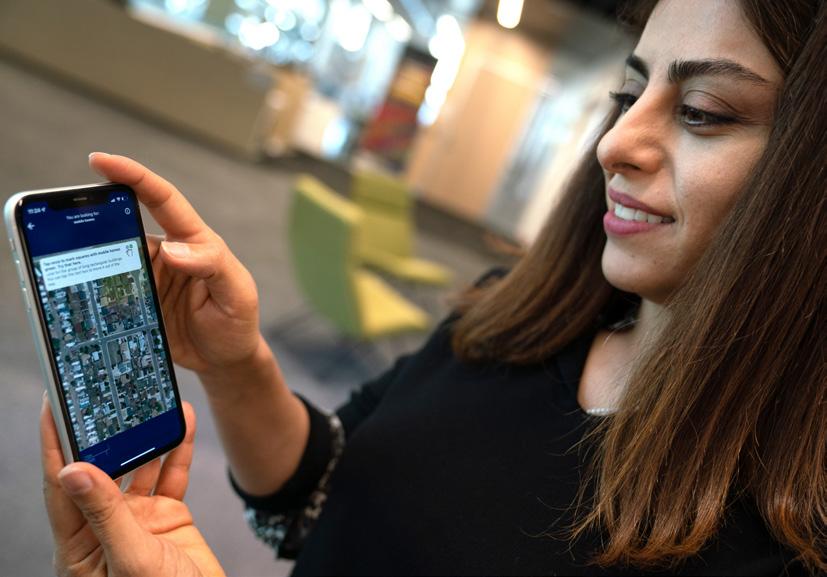
data? Contact us at resilience@asu.edu

Finding shared beliefs to improve cross-sector collaboration
community partnerships
Got
“To get a bird’s eye view of all mobile home park locations across Arizona, we teamed up with the Missing Maps Project’s MapSwipe app. Together we will be able to find mobile home residents who are the most vulnerable to heat and bring more resilient solutions to those who are falling between the cracks.”
— MARYAM SHAFIEE SHAKIB GRADUATE RESEARCH ASSISTANT KNOWLEDGE EXCHANGE FOR RESILIENCE


We support the development of transformative solutions that enhance community resilience at a systems level.
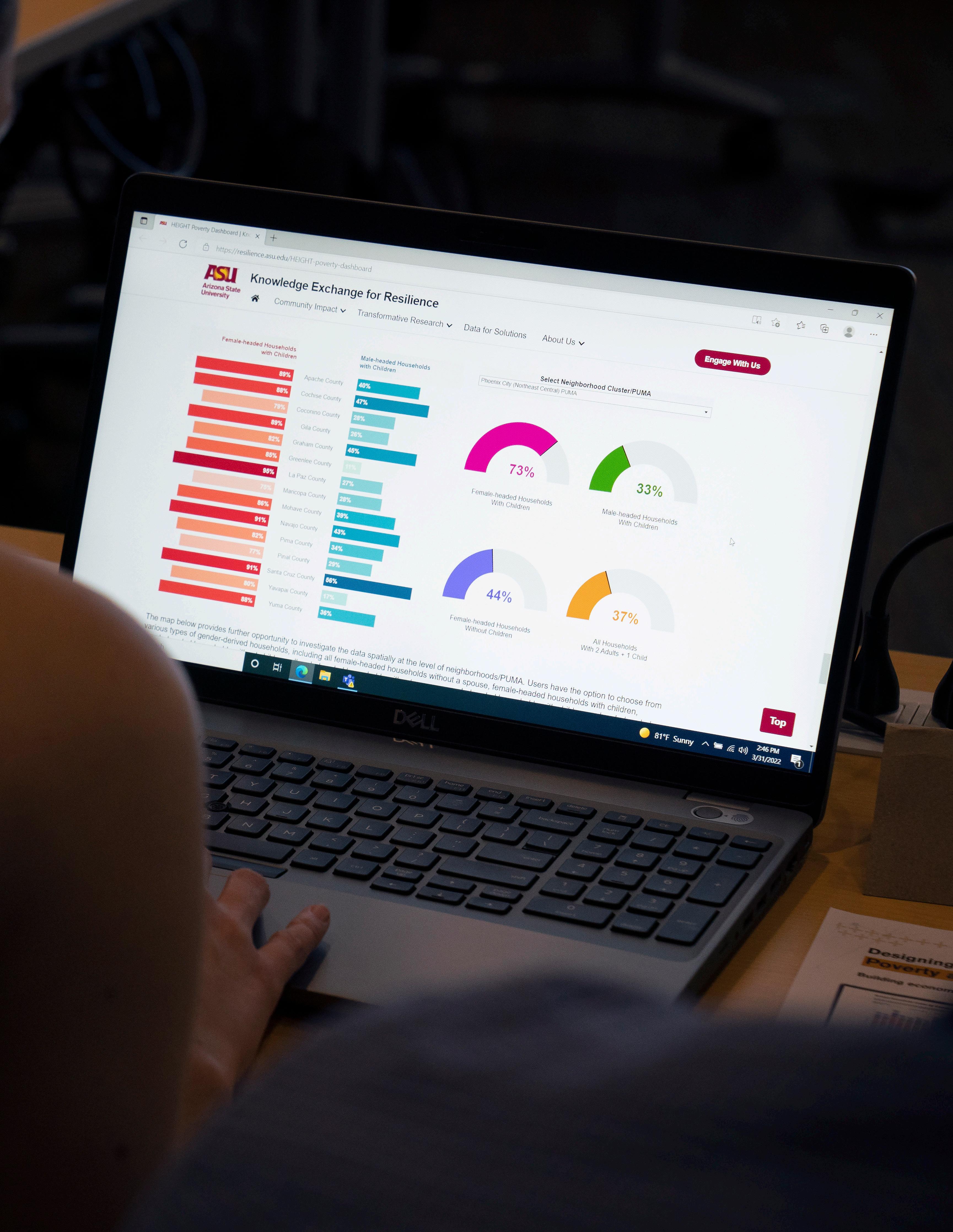
By designing for resilience dividends, we can reap additional benefits in social cohesion, economic prosperity and environmental security.
Living costs in Arizona, including housing, health care and child care, have risen dramatically in the last decade, outpacing wage increases, yet the federal poverty measure does not yet factor these essential costs into its calculation, limiting its assessment criteria to food costs alone.
It also fails to account for regional variations in the cost of living, which in Maricopa County are significantly higher than state or national averages. Depending upon this method of defining poverty means many families in need of assistance are deemed ineligible.

This year’s Designing for Resilience Dividends tackled this challenge, inviting participants to explore and provide feedback on a new data tool that attempts to address these gaps and capture the real nature of poverty.
Starting in 2019, KER partnered with Valley of the Sun United Way to design a unique tool to measure and visualize the true costs of living at the neighborhood scale, highlighting the emerging gap between household income and living costs.
Using federal data from multiple federal and state sources, as well as the Council for Community and Economic Research,
the tool builds a living cost budget for various family sizes accounting for the costs of food, housing and utilities, health care, child care, transportation, taxes and other essential needs. Analyzing those local costs of living with the household’s income data, it determines how many households are struggling to meet basic living costs across neighborhoods.
“The data also provides insights about families with different characteristics — whether the household includes children, whether the head of household is male or female, the number of adults in the household, and the ethnicity of householders — to enable communities to design interventions targeted to their specific needs,” said Sarbeswar Praharaj, KER’s associate director for data and visualization.
By inviting potential end users from local nonprofit and private organizations, we were able not only to capture valuable input that helped us refine the tool, but also to generate interest and buy-in among stakeholders.
Explore the tool at resilience.asu.edu/HEIGHT-poverty-dashboard





In order for discoveries to drive real change, they must be actively shared with decision makers and the public at large. At KER, we’ve stepped up our efforts this year to get ASU research results into the hands of people in the position to act on them. And we’ve deepened our engagement with partners to pilot and advise on solutions of public value.
With the state legislature forming an interim Housing Supply Study Committee, our team had a fantastic opportunity to share our research on the nexus of housing security and heat resilience. Melissa Guardaro, associate director for resilience hubs, and Lora Phillips, associate director for broader impacts, presented KER’s work at a committee meeting on the environmental impacts of increasing housing supply.
Emphasizing rising temperatures and eviction rates, and noting the particular vulnerability of mobile home residents, they testified to the need to increase housing stock that’s both affordable and easily cooled, even on extreme heat days.
Watch their presentations at bit.ly/housing-supply-study

In the U.S., more people die from heat than from all other natural disasters combined. What if the Federal Emergency Management Agency (FEMA) declared heat an eligible hazard, similar to floods and hurricanes, so the nation could mobilize its resources to respond?

To plant this seed and build capacity among resilience professionals beyond Arizona, KER worked with FEMA, the City of Phoenix and the University of Arizona to lead a Resilient Nation Partnership Network webinar discussing the impacts of extreme heat across the country. The event included breakout sessions on extreme heat and housing, extreme heat as a threat multiplier, extreme heat as a public health hazard, and extreme heat in light of local planning and capital improvement.

infrastructure buckles, when too many employees can’t get to work, when too many residents overwhelm the heat relief system all at once? What else can be done in advance to our city infrastructure to mitigate these future shocks, which are expected to worsen with anticipated increased temperatures in years to come?
By sharing our expertise about the social infrastructure of heat responses and brokering relationships with local governments and other civil society organizations, we helped Swiss Re to understand the risk landscape and to design future insurancebased solutions to help manage heat risk.
Our team worked with insurance provider Swiss Re to exchange knowledge around the risks of extreme heat and to connect the insurance industry with designs to mitigate heat resilience. At the moment, municipalities assume the risk for extreme heat in their budgets, but how many are prepared for a worst case scenario? What happens when the energy
While people 65 and older only make up 16% of the population in Maricopa County, they account for 21% of outdoor heat deaths and a staggering 65% of indoor heat deaths. We partnered with the Virginia G. Piper Charitable Trust to host a seminar for their Grantmakers in Aging Conference on the heat and housing challenges faced by elders.
Our team shared our research on the factors that put older residents at greater risk and highlighted solutions that could be implemented at various scales to improve their housing security and heat resilience. We invited a panel of experts from AARP Arizona, the Arizona Association of Manufactured Home and RV Owners, the City of Tempe and the City of Phoenix to add their experiences on working to address this vulnerability.
Read the narrative presentation at bit.ly/housing-heat-aging


Seeding new ideas and partnerships at Extreme Heat Resilience Ideation Hour
Laying the foundation to help cities mitigate extreme heat emergencies
awareness about vulnerabilities and solutions for older residents
Philanthropic seminar on housing, heat and aging


When communities are involved in decisions about where to allocate resources, resilience initiatives are more likely to be successful. We also gain the dividend of investing in greater social cohesion, which itself builds resilience in our neighborhoods.

This year our partners at the Maricopa County Department of Public Health and Salud en Balance — led by Gail LaGrander and Teresa Sosa — completed a project that began with 2020 Resilience Fellow Molly Benton to engage local residents in the decision making process. Using a participatory budgeting process, volunteers collected ideas from 120 community members and presented eight for public voting. The winning proposals included a computer lab to disseminate critical information and a program offering cooling equipment to residents.


These projects will increase access to knowledge and improve health outcomes. But perhaps more importantly, the budgeting process itself enhanced the community’s ability to adapt to future shocks and stressors by building capacity in democratic decision making, empowering neighborhood leadership and planting the seeds for greater social cohesion.
This summer, KER worked with multinational company 3M and partner SkyCool to help them test a new cooling film they’ve been developing. Leveraging our deep connections with Mesa’s mobile home communities, we provided an opportunity for the company to understand how their innovation could help the most vulnerable and for residents to get involved with the development of this new technology. Engaging real world users’ perspectives yielded a number of discoveries about social adaptation beyond what a traditional laboratory could offer.
While our team is still analyzing data from interviews and temperature recordings, our partners at 3M and SkyCool have already gained valuable insights about the lived experiences of potential consumers and about how their product performs on the ground.
Working with communities to mobilize resources that build resilience
Executive director Patricia Solís and GIS analyst Abdulrahman “Al” Alsanad served as mentors at Hacktivate Mesa, an opportunity for local high school students to discover, study, analyze and present data about an issue or challenge facing our community. Their student team from Westwood High School IB program won their category for their work on the topic of “Heat Mitigation Through Native Vegetation”.



In KER’s four years of operation, our leaders, scholars, partners and students have empowered Maricopa County’s public and nonprofit institutions to become more resilient to the shocks and long-term stress of summertime heat and the amplifying effects it has on the economy, human health, energy transitions, housing and homelessness, and food production. This growth in capacity developed through an exchange of ideas and data via a highly connected social network across Maricopa County, the state of Arizona and the U.S. The creation and the use of the network has transformed the way ASU conducts cutting edge research and generates innovative solutions.


KER is scaling up our impact by partnering more closely with federal agencies and embarking upon more federally funded projects.
CDC – $450,000
• Adaptation strategies that protect and promote human health: Hondula, Guardaro & Georgescu
DOE – $25,000,000
• Southwest Urban Corridor Integrated Field Laboratory: Sailor, Solís, Vanos, Gerogescu & others
EPA – $75,000
• Heat action planning for environmental justice: Winkle & Guardaro
NASA – $639,484
• Technical and soft skills training for women in environmental and geospatial science: Solís & Frazier
NEA – $35,000
• Community engagement to design a cooler Phoenix: Hondula, Guardaro, Middel, Vanos & Coseo
NOAA – $149,998
• Assessing future satellite sensors to improve air quality impacts: Lant, Fraser, Bryan & Solís
NSF – $2,136,790
• Complementing official data with crowdsourced spatial data: Solís
• Using predictive analytics to track COVID-19 spread: Dasarathy, Liu, Solís, Turaga & Cochran
• Bio-social modeling of unseen pandemics: Turaga, Pedrielli, Johnston, Dasarathy, Li, Woodbury, Solís, Simeone, Berisha, Sankar
• Training next-gen Arctic scientists in AI driven analytics: Li & Solís
USAID – $4,588,500
• YouthMappers: Open spatial data for community resilience: Solís
USDA – $74,997
• Food security and crop identification mapping pilot: Solís
USGS – $24,982
• National Map translation: Solís
USTDA – $750,000
•
Accelerating solar mini-grid deployment in Fiji: Johnson & Solís
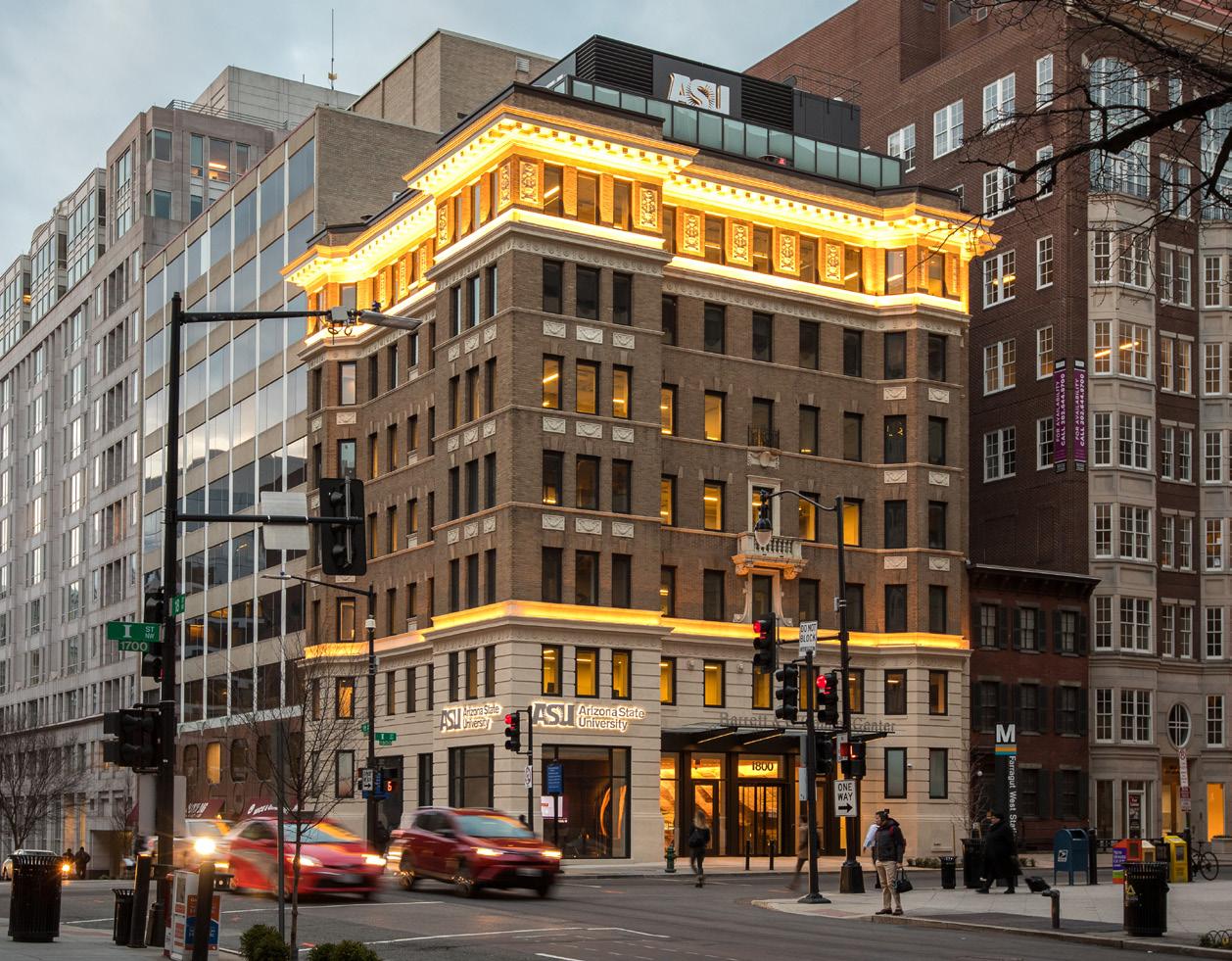


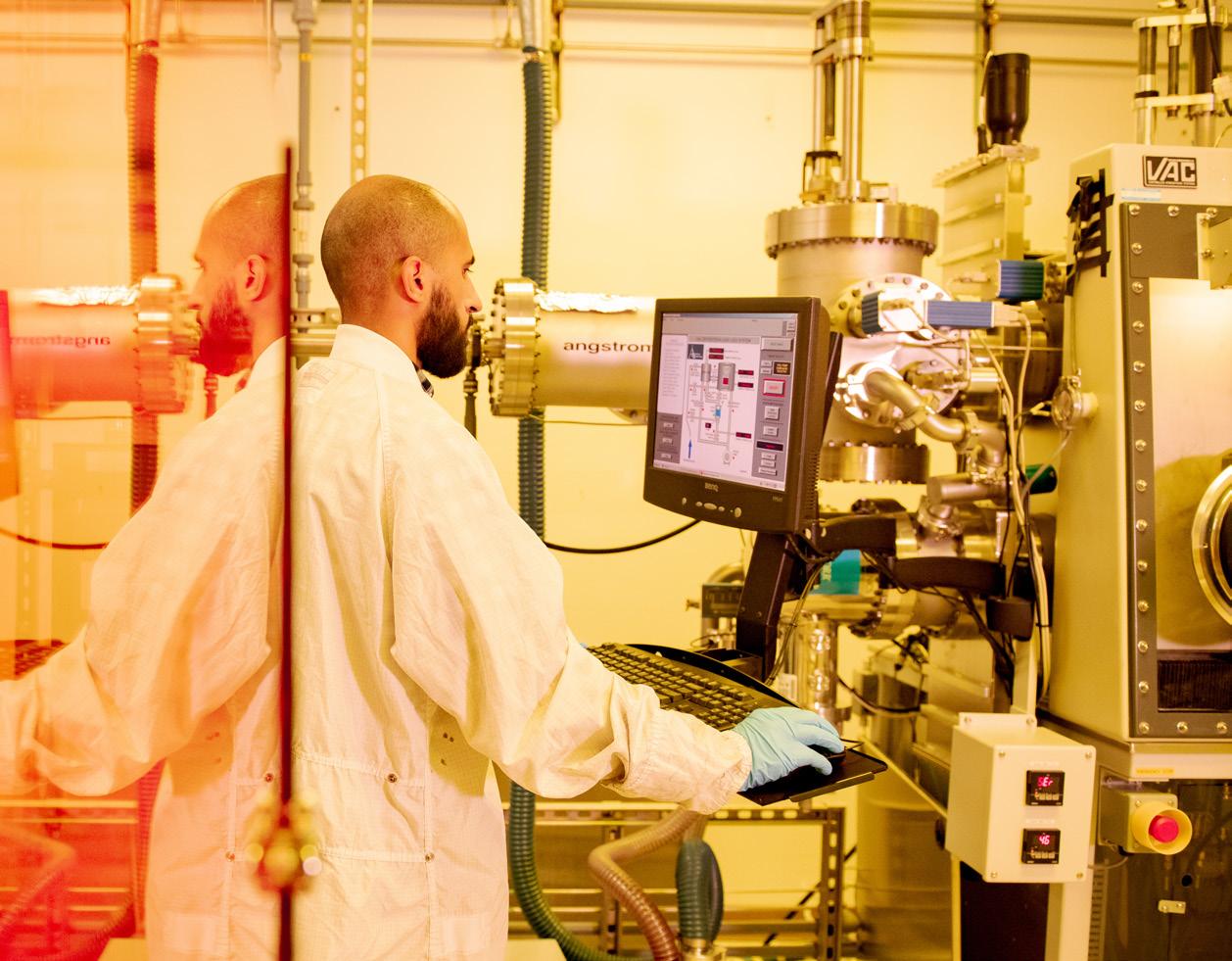

Engaging with the media plays a critical role in our knowledge exchange, allowing us to share information with a wider audience, connect with new partners and scale our impact beyond the borders of our county. Our team contributed its expertise to the following stories this year.
The Geoholics
Episode 139 - Patricia Solis: “Be a Great Ancestor”
Grist
As a heat wave grips the US, lessons from the hottest city in America
Slate
Mobile homes have a major climate change problem
Through the Human Geography Lens YouthMappers for global good with Dr. Patricia Solis
The Guardian Unhoused in Phoenix’s perilous heat: ‘If I don’t keep cool, I’ll die’


“Fundamentally, to get ahead of heatassociated deaths and illness, we must look at housing and come up with innovative city and state wide systematic solutions.”
Executive director Patricia Solís shares our research on heat and housing in this article on the impacts of extreme heat on people experiencing homelessness.
NPR Tempe creates an emergency response center to be a refuge in a climate disaster
Melissa Guardaro, associate director for resilience hubs, discusses the need for more spaces like Tempe’s new Envision Center to help residents cope with cascading shocks, such as a historic heat wave that causes power and water outages.
“I think anybody who works in this extreme heat space is not worried that it’s going to happen so much as it’s going to happen; it’s just a matter of when.”
Local
ABC15 Arizona
Prepping for extreme heat: Tempe working to open its first ‘envision’ center
Arizona’s Family
Over one-third of heat-related indoor deaths occur in manufactured or mobile homes
FOX 10 Phoenix
Arizonans living in mobile or manufactured homes are at higher risk in the heat, research suggests
Arizona’s housing crisis goes hand-in-hand with the state’s water and heat crises
“Despite the fact that only 5% of Maricopa County residents live in mobile homes, a really disproportionate 31% of all indoor heat-related deaths between 2011 and 2020 occurred in mobile homes.”
Lora Phillips, associate director for broader impacts, is quoted in this article on the interrelated heat, housing and water crises in Arizona.
InHospitable: Heat
‘You’re living in a tin can’ ‘Estás viviendo en una lata’
City planners have tools to deal with heat. A new survey finds many may not be using them
Hot Town: Nearly 30% of metro Phoenix’s heat-related deaths occur in manufactured homes
ASU
ASU leads $25M project to develop Southwest urban integrated field laboratory
ASU leaps to No. 2 globally for UN Sustainable Development Goals, retains top US spot
ASU professor recognized for urban heat resiliency research
ASU professors to be recognized at American Association of Geographers annual meeting
ASU’s Wentz honored with mentoring award in geographic information sciences
ASU News
Is AI the answer to the Arctic’s climate change problems?
ASU News
Scientists get boost at ASU for their climate change work in the Amazon
Extreme heat and air pollution create an uneven and risky playing field
“Sport shines a global spotlight on these uneven burdens in outdoor sporting activities at every level, where environmental injustices and racism widen the gap in access to clean air and manageable temperatures.”

Impact scholar Jennifer Vanos writes about the need to create healthy and safe outdoor spaces for all athletes.
Researchers aim to find more effective ways of coping with overexposure to extreme high temperatures
Market failure: ‘It falls on all of us to end the housing crisis’

Building heat resilience with Kathy Baughman McLeod & David Hondula
One of our many tools of knowledge exchange is publishing what we discover together in peer-reviewed journals. By sharing these findings in formal scientific outlets, we can help build a robust repository of information to enhance community resilience.
Below is a list of published articles, book chapters and presentations from this year that address relevant topics related to community resilience in Maricopa County, and around the world. The following bibliography reflects some of the direct contributions by KER’s faculty, students and partners.
Batur, I., Markolf, S. A., Chester, M. V., Middel, A., Hondula, D., & Vanos, J. (2022). Street-level heat and air pollution exposure informed by mobile sensing. Transportation Research Part D: Transport and Environment 113(103535) https://doi.org/10.1016/j. trd.2022.103535
October 21). Public spaces under the smart cities paradigm in India [Conference presentation]. Smart Data Smart Cities & 3D GeoInfo Joint International Conference, Sydney, Australia.
Learn more about the FUSE resilience themes at: https://resilience.asu.edu/FUSE-themes
Berbés-Blázquez, M., Schoon, M., Benessaiah, K., Bennett, E. M., Peterson, G. D., & Ghimire, R. (2022). Resilience in the times of COVID: what the response to the COVID pandemic teaches us about resilience principles. Ecology and Society 27 (2):16. [online] https://www. ecologyandsociety.org/vol27/ iss2/art16/
DeWaard, J., Hunter, L. M., Mathews, M. C. et al. (2022). Operationalizing and empirically identifying populations trapped in place by climate and environmental stressors in Mexico. Regional Environmental Change 22(29), https://doi.org/10.1007/ s10113-022-01882-7
Playground Shade Index: A new design metric for measuring shade and seasonal ultraviolet protection characteristics of parks and playgrounds. Photochem Photobiol. Accepted Author Manuscript. https://doi.org/10.1111/ php.13745
Öner, Ö., Pumain, D., Stewart, K., Tong, D., Wentz, E. A. (2022.) Commentary: Making space in geographical analysis. Geographical Analysis https:// doi.org/10.1111/gean.12325
Das, I. & Praharaj, S. (2022,
Downs, N., Raj, N., Vanos, J., Parisi, A. V., Butler, H., Deo, R., Igoe, D., Dexter, B., Beckman-Downs, M., Turner, J. and Dekeyser, S. (2022). The
Franklin, R. S., Delmelle, E. C., Andris, C., Cheng, T., Dodge, S., Franklin, J., Heppenstall, A., Kwan, M., Li, W., McLafferty, S., Miller, J. A., Munroe, D. K., Nelson, T.,
Guardaro, M., Hondula, D. M., Ortiz, J., & Redman, C. L. (2022). Adaptive capacity to extreme urban heat: The dynamics of differing narratives. Climate Risk Management, 35. https://doi.org/10.1016/j. crm.2022.100415
Guardaro, M., Hondula, D. M., & Redman, C. L. (2022). Social capital: improving community capacity to respond to urban heat. Local Environment, https:// doi.org/10.1080/13549839.20 22.2103654
Phillips, L. A. & Rhodes A. P. (2022, April 8). Late career precarious work and racial-ethnic inequalities in later life poverty [Conference presentation]. Population Association of America Annual Meeting, Atlanta, GA, United States.
Mahtta, R., Fragkias, M., Güneralp, B., Mahendra, A., Reba, M., Wentz, E. A. & Seto, K. C. (2022.) Urban land expansion: the role of population and economic growth for 300+ cities. Urban Sustainability 2(5). https://doi.org/10.1038/ s42949-022-00048-y
McCusker, B., Ahmed, W., Ramutsindela, M., & Solís, P. (Eds.). (2022). The Routledge handbook of development and environment. Routledge.
National Academies of Sciences, Engineering, and Medicine. (2022). Toward a 21st century national data infrastructure: Mobilizing information for the common good. Washington, DC: The National Academies Press. https://doi.org/10.17226/26688

Solís, P. (Panelist and Contributor)
Praharaj, S. (2022). Reconnecting communities with public spaces: A proposal for rejuvenation of sacred Kunds in the historic city of Varanasi. In: Singh, R.S., Dahiya, B., Singh, A.K., Poudel, P.C. (eds) Practising Cultural Geographies. Advances in 21st Century Human Settlements. Springer, Singapore. https://doi. org/10.1007/978-981-16-64151_7
Mehner, A. (2022, January 26). Avoided residential air conditioning energy costs associated with cooling the city: A case study for Phoenix Arizona USA [Symposium session]. 17th Symposium on Societal Applications: Policy, Research and Practice, AMS 102nd Annual Meeting, Houston, TX, United States.
mapping towards Sustainable Development Goals: Voices of YouthMappers on community engaged scholarship. Springer Nature Sustainable Development Goals Series, ISBN: 978-3031-05184-5. Open Access: https://link.springer.com/ book/9783031051814
Shortridge, A., Walker VI, W., White, D. D., Guardaro, M. M., Hondula, D. M., & Vanos, J. K. (2022). HeatReady schools: A novel approach to enhance adaptive capacity to heat through school community experiences, risks, and perceptions. Climate Risk Management, 36(100437), https://doi.org/10.1016/j. crm.2022.100437
* Villa, L. K., Murugesan, S. B., Phillips, L. A., Drake, A. J., & Smith, N. A. (2022). Mobile pantries can serve the most food insecure populations. Health Equity, 6(1), 49–50. http://doi.org/10.1089/ heq.2021.0006
Phillips, L. A. (2022, August 6). Who evicts?: Eviction filings by local versus non-local landlords in Maricopa County, Arizona [Conference presentation]. American Sociological Association Annual Meeting, Los Angeles, CA, United States.
Praharaj, S., Kaur, H. & Wentz, E. (2022). The spatial association of demographic and population health characteristics with COVID-19 prevalence across districts in India. Geographical Analysis https:// doi.org/10.1111/gean.12336
Praharaj, S. & Wentz, E. (2022, October 21). Building community resilience through geospatial information dashboards [Conference presentation]. Smart Data Smart Cities & 3D GeoInfo Joint International Conference, Sydney, Australia.
Sailor, D. J., Wentz, E., Anand, J., Alhazmi, M., Aguilar, E.,
Shutters, S. T., Applegate, J. M., Wentz, E., & Batty, M. (2022.) Urbanization favors high wage earners. Urban Sustainability, 2(6). https://doi. org/10.1038/s42949-02200049-x
Solís, P., Varfalameyeva, K., & Hernandez, C. A. (2022.) Heat resilience among mobile home owners in Arizona: Towards a multiscale approach to address spatial incongruence and accountable decision making. GeoJournal. In Publication.
Wu, H., Peek, L., Mathews, M. C., & Mattson, N. (2022). Cultural competence for hazards and disaster researchers: Framework and training module. Natural Hazards Review https:// doi.org/10.1061 (ASCE) NH.1527-6996.0000536.
* Indicates a community co-author
Solís, P. & Zeballos, M. (Eds.). (2023). Open
Elizabeth Wentz
Director
Patricia Solís
Executive Director
Susana Bustillos Assistant Director
Marcia Nation
Evaluator
Jamie Colburn Research Administrator
Travis Craddock
Associate Director of Development

Melissa Guardaro
Assistant Research Professor and Associate Director for Resilience Hubs
Mason Mathews
Assistant Research Professor and Associate Director for Academic Integration and Alliances
Sarbeswar Praharaj
Assistant Research Professor and Associate Director for Data and Visualization
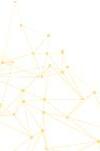
Lora Phillips
Assistant Research Professor and Associate Director for Broader Impacts
Shea Lemar
Director, Geospatial Research & Solutions
Abby Johnson
Communications Manager
Brajesh Karna Data Manager
Abdulrahman “Al” Alsanad GIS Analyst
Giovanna Arenas Events Coordinator
Chelsea Dickson Project Manager, Liaison to the Decision Theater
Katsiaryna Varfalameyeva Research Assistant
Elisha Charley
Graduate Research Assistant
Natalia da Silveira Arruda Graduate Research Assistant
Alexandria Drake
Graduate Research Assistant
Carlos Aguiar Hernandez Graduate Research Assistant
Negar Rahmatollahi Graduate Research Assistant
Maryam Shafiee Shakib
Graduate Research Assistant
Kevin Jatin Vora
Graduate Research Assistant
Deep Vijaykumar Patel Research Assistant
Nishta Shah Research Assistant
Claire Nelson Research Aide
Rishabh Krishnakant Pandat Research Aide
Nicholas Kenney Research AideDavid Adame
Chicanos Por La Causa
Teniqua Broughton
The State of Black Arizona
Greg Burton
Arizona Republic
Maria Dadgar
Inter Tribal Council of Arizona
Kate Gallego
City of Phoenix
Neil Giuliano
Greater Phoenix Leadership
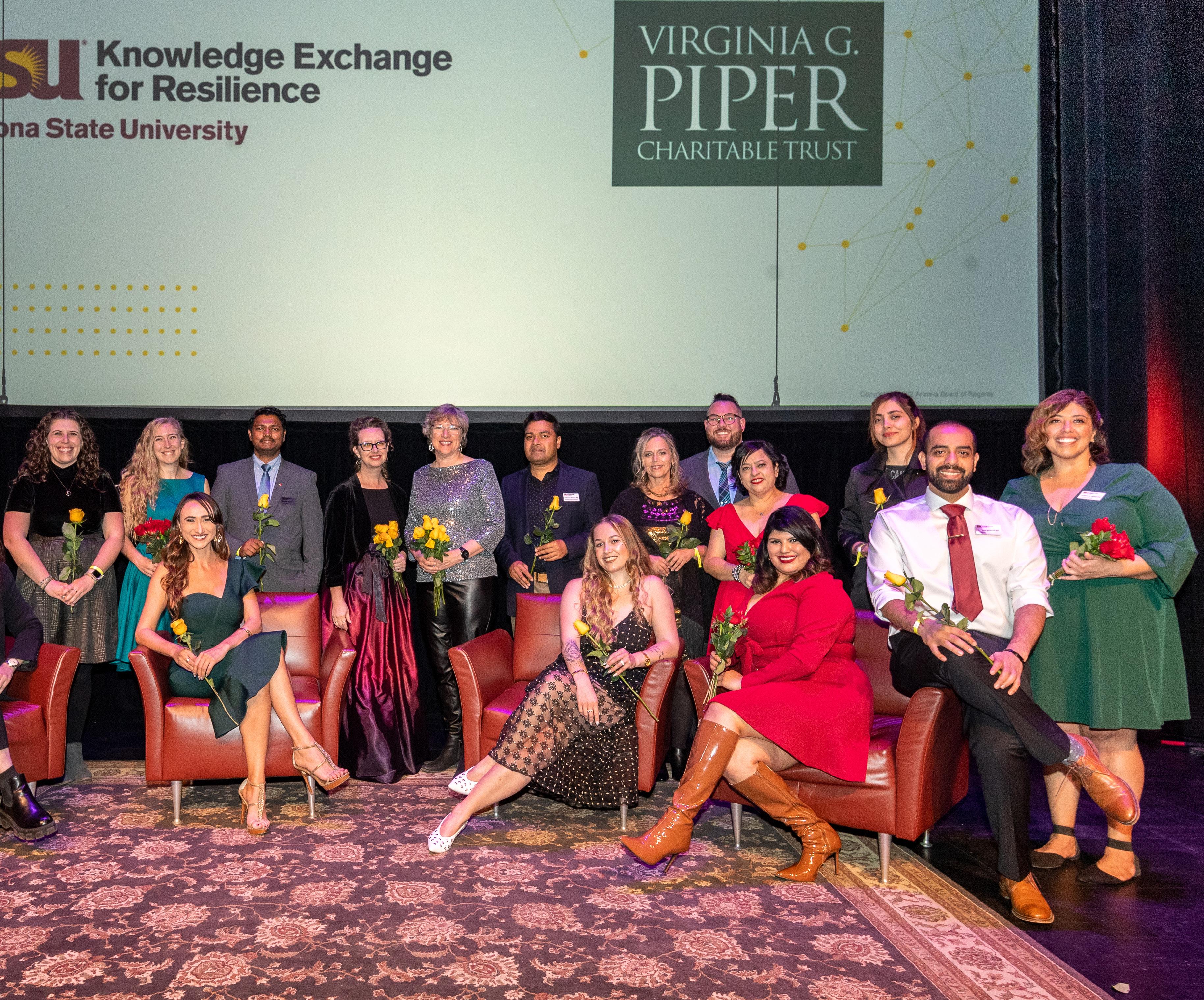
Jeff Guldner
Arizona Public Service Company
Dana Marie Kennedy
AARP Arizona
David Lujan
Children’s Action Alliance
David Rousseau
Salt River Project
Amy St. Peter
Maricopa Association of Governments

Monica Villalobos
Arizona Hispanic Chamber of Commerce
Cynthia Zwick
Wildfire

The ASU Knowledge Exchange for Resilience is supported by Virginia G. Piper Charitable Trust. Piper Trust supports organizations that enrich health, well-being, and opportunity for the people of Maricopa County, Arizona.
Funding support also received from:
Environmental Protection Agency
Institute for Social Science Research (ISSR) at ASU
NASA
National Science Foundation US Agency for International Development
US Geological Survey US Department of Agriculture National Endowment for the Arts
ADVANCE*
Barrett, The Honors College*
Biosocial Complexity Initiative
Center for Emergency Management and Homeland Security
Center for Smart Cities and Regions
College of Integrative Sciences and Arts
Decision Theater*
Edson College of Nursing and Health Innovation
Equitable Places Lab Foundation for A New American University*
Geospatial Research and Solutions*
Global Futures Laboratory*
Global Sport Institute
Healthy Urban Environments*
Herberger Institute for Design and the Arts
Hugh Downs School of Human Communication
Ira A. Fulton Schools of Engineering Knowledge Enterprise Laboratory for Energy And Power Solutions (LEAPS)* Library Mirabella Morrison Institute for Public Policy* NEXUS Lab
Office of Applied Innovation
Office of Presidential Initiatives
OKED Broader Impacts Group
Rob and Melani Walton Sustainability Solutions
Sandra Day O’Connor College of Law
School for Engineering of Matter, Transport and Energy
School for the Future of Innovation in Society
School of Arts, Media and Engineering School of Community Resources and Development
School of Complex Adaptive Systems School of Computing, and Augmented Intelligence School of Geographical Sciences and Urban Planning*
School of Human Evolution and Social Change
School of Social Work School of Sustainable Engineering and the Built Environment School of Sustainability
Smart City Cloud Innovation Center Southwest Borderlands Initiative
SPARC Lab*
Stardust Center for Affordable Homes and the Family
Studio for Creativity, Place, and Equitable Communities
Sustainable Cities Network
TenAcross 10X
The Graduate College*
The Polytechnic School
University City Exchange
Urban Climate Research Center
W. P. Carey School of Business*
Walter Cronkite School of Journalism and Mass Communication
Watts College of Public Service and Community Solutions
YouthMappers*
3M and Skycool*
AARP Arizona
Amazon Web Services

American Red Cross
APS
Arizona Association of Manufactured Home, RV and Park Model Owners
Arizona Department of Economic Security
Arizona Department of Housing Arizona Housing Coalition
Arizona Housing, Inc. (AHI)
AZ Hispanic Chamber of Commerce
AZCEND
Black Chamber of Arizona
Borns Solutions AZ
Center for Economic Integrity Center for the Future of Arizona
Chicanos por la Causa
Children’s Action Alliance
City of Mesa
City of Phoenix
City of Scottsdale
City of Surprise
City of Tempe
Corporation for Supportive Housing Crisis Response Network
Dress for Success Phoenix
Federal Emergency Management Agency Resilient Nation Partnership
Feed Phoenix Fervor Creative Garcia Family Foundation
Global Council for Science and the Environment
Greater Phoenix Economic Council

Greater Phoenix Leadership Inter Tribal Council of Arizona
Keep Tempe Beautiful
Manufactured Housing Communities of Arizona
MapSwipe
Maricopa Association of Governments
Maricopa County Public Health Department*
Meritage Homes
MesaCAN
Missing Maps
New America
Paideia Academies Inc
Phoenix Rescue Mission
RAIL Community Development Corporation
Salt River Pima-Maricopa Indian Community
Salt River Project Salud en Balance
Salvation Army
St. Vincent de Paul Swiss Re
The Arizona Republic
The Connective
The State of Black Arizona
Unite Us
University of Arizona*
US Census Bureau
Utility Assistance Coalition Network
Valley of the Sun United Way Vitalyst Health Foundation Wildfire
* indicates shared resources, data, agendas, or personnel
Art, color, texture and the visual environment have always been central to Jennifer’s world. She is a self-taught artist working primarily with acrylic paint and chalk pastels. Inspired by the color and shapes of nature and the landscape around her, she gravitates to painting with dynamic color palettes on large-scale canvas. With a background in the clothing industry, she has also created a technique to naturally dye silks using the power of the Arizona sun.
Having received a formal education at Colorado State University — Bachelor of Science in Textiles with Apparel Design Concentration — Jennifer has worked in the clothing and textile industry for over 20 years. This led her to working with customers and factories across New Zealand, Australia, Asia and Europe. Always with camera in hand, capturing moments and colors of the region. She studied with celebrated NZ artist Josie Martin (The Giant’s House, Akaroa) and prolific California painter Robert Burridge. She enjoys teaching others how to make arts and crafts as well. She taught adults with physical and mental disabilities at Very Special Arts in Madison, WI and inspired disadvantaged children at Free Arts Arizona.
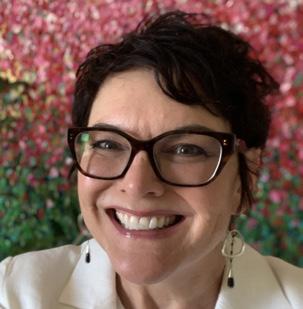
Jennifer’s art is in private collections in New Zealand, Wisconsin, New Mexico and Arizona.
See more of Jennifer’s work at etsy.com/shop/ sunnyslopedesign and on Instagram @jeng_sunnyslope resilience.asu.edu
